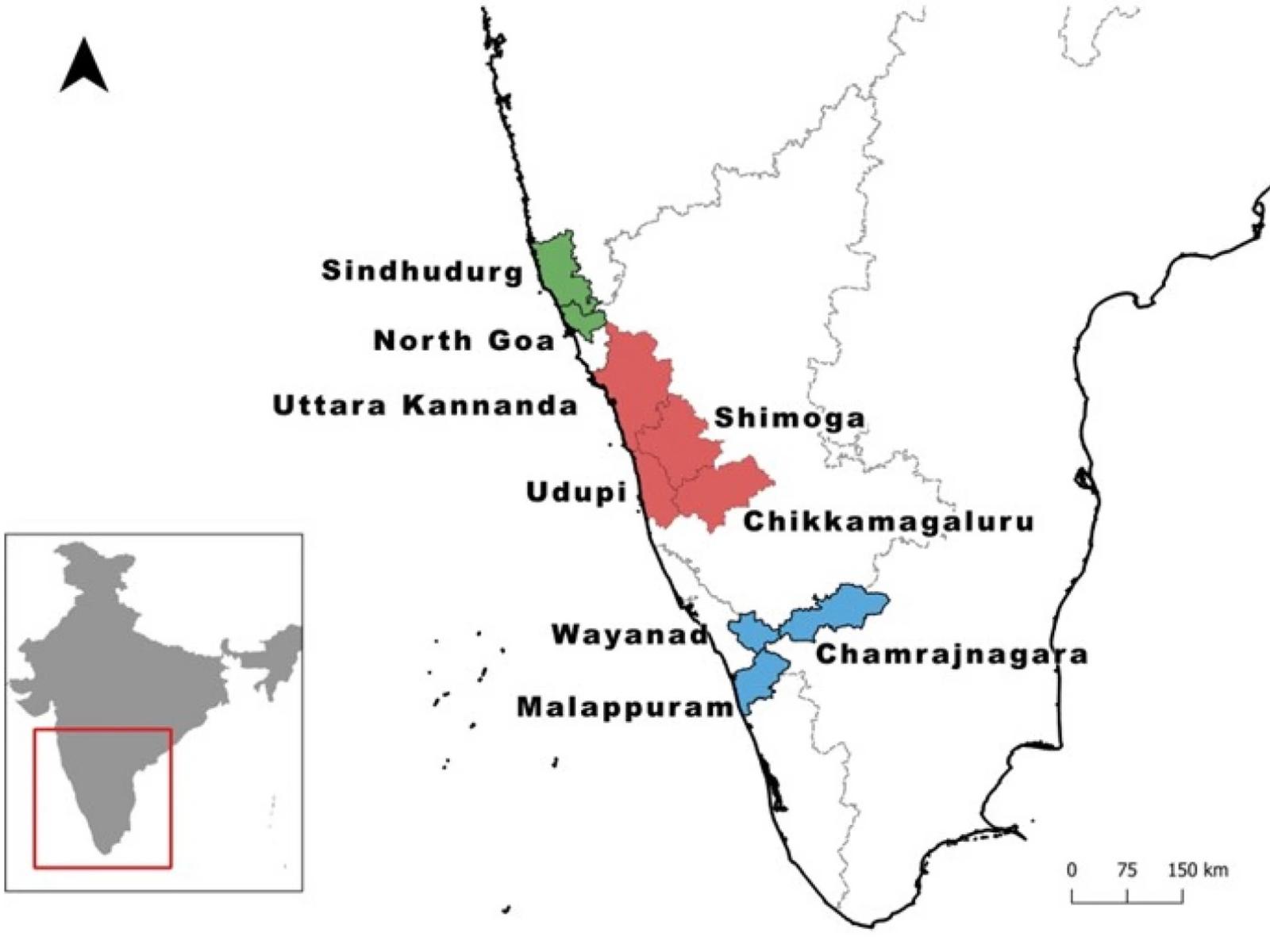Using New Predictive Approaches to Curtail Kyasanur Forest Disease Outbreaks
Transfer learning techniques and event-based surveillance used in regions with little to no historical data

District-level locations of KFD presence in India between 2010 and 2019. Historically endemic to the red region, overtime KFD spread to the blue and then green regions highlighted in the map.
(QGIS© 3.28.8 software map generated by Ravikiran Keshava Murthy and Lauren Charles | Pacific Northwest National Laboratory)
The Science
In 1957, Kyasanur forest disease (KFD) was first identified in the Kyasanur Forest in India. Since then, KFD has concerned scientists who have seen the disease spread to new areas, infect 400-500 humans each year, and disproportionately impact poor and underprivileged communities living in or near forest areas. Yet, the disease, a tick-borne viral hemorrhagic fever, is historically understudied.
Faced with limited data, researchers at Pacific Northwest National Laboratory (PNNL) studied different techniques to improve disease prediction in resource-limited settings. The team’s goal was to identify the best approach to forecast KFD cases at both the national and regional levels for better situational awareness and actionable decision-making.
The Impact
In a perfect scenario, accuracy, completeness, reliability, relevance, and timeliness are the foundations of quality data. The reality is that those elements don’t always exist. In the KFD study, the PNNL team found considerable underreporting and delayed reporting of KFD events by official agencies, specifically at the district and state levels, which is common in low-resource settings.
PNNL’s study is the first to demonstrate the merits of combining open-source, unofficial case count data from local news and internet searches with traditional climate data to strengthen the predictive capabilities of KFD. As an alternative to historic data obtained from official sources, the media’s unofficial case counts could be used to produce timely and reliable nowcasting and short-term forecasting estimates. This study is also the first to generate KFD time-series prediction models, both at the national and regional levels, using advanced machine learning algorithms and transfer learning techniques.
“We show that transfer learning techniques can be used to predict disease presence in regions with little to no traditional surveillance data or history of disease, which is a major obstacle for new and re-emerging diseases,” said Lauren Charles, PNNL chief data scientist. “We also found that event-based surveillance using internet-based, open-source news reporting can be extremely useful even in very remote, underdeveloped areas.”
Summary
“Kyasanur forest disease is often underreported or unreported by local authorities to central health agencies, hence hindering control and prevention efforts,” said Ravikiran Keshava Murthy, lead author and doctoral candidate in the PNNL-WSU Distinguished Graduate Program, who is working with Charles at PNNL. “Our study demonstrates how open-source biosurveillance data and machine learning can be utilized to forecast neglected zoonotic diseases, such as KFD, when official reporting is unreliable or delayed.”
Using KFD as a case study, the PNNL team researched emerging zoonotic disease prediction when the available epidemiological information is limited. The novel sources of data and advanced machine-learning approaches, such as event-based surveillance and transfer learning, demonstrated the potential to increase disease prediction capabilities.
The researchers hope the governmental health agencies and other stakeholders, both at the local and national levels in a One Health context, will use the results from the study to strengthen disease surveillance and improve decision-making in resource-limited regions, like KFD in India.
Contact
Lauren Charles
Pacific Northwest National Laboratory
Lauren.Charles@pnnl.gov, (509) 372-4976
Funding
This research was funded by the Defense Threat Reduction Agency Department of Defense Sector. PNNL is a multi-program national laboratory operated by Battelle for the Department of Energy under contract No. DE-AC05-76RL01830.
Published: August 7, 2023
Keshavamurthy, R., Charles, L.E. 2023. “Predicting Kyasanur forest disease in resource-limited settings using event-based surveillance and transfer learning.” Sci Rep 13, 11067. https://doi.org/10.1038/s41598-023-38074-0.